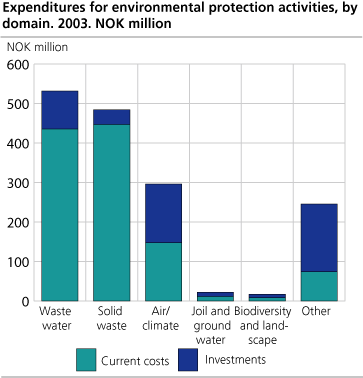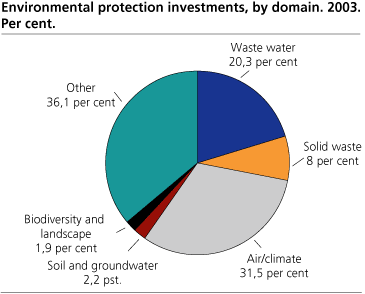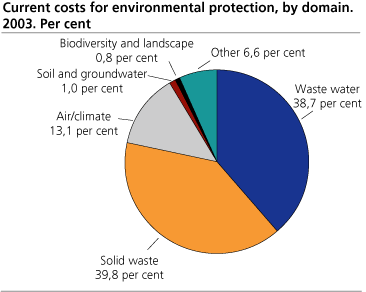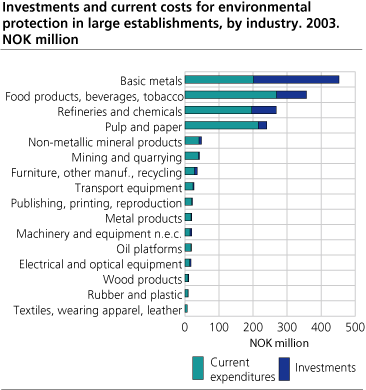Content
Published:
This is an archived release.
NOK 1.6 billion spent on environmental protection
Norwegian establishments spent NOK 1.6 billion on environmental protection in 2003. NOK 1 billion was spent on treatment of waste water and solid waste, and they also invested in equipment for cleaner air.
For 2003, Norwegian establishments in the manufacturing, mining and quarrying industries reported about NOK 1.6 billion related to environmental protection expenditure. NOK 1.1 billion were current costs and NOK 0.5 billion were investments. This is about 4.7 per cent of these establishments' total gross investments and 0.4 per cent of their total current costs. This figures are based on a survey including the 1 159 largest establishments in manufacturing, mining and quarrying industries.
Highest expenditures for waste water and solid waste
The figures for 2003 show that the highest expenditures were for activities related to waste water and solid waste. The expenditures for waste water and solid waste were 1.0 billion, or 64 per cent of the total reported environmental protection expenditures in the sample. The expenditures for these two environmental domains are dominated by current costs and the investments are small. The two domains cover 78 and 28 per cent of the sample's current costs and investments.
Expenditures for air /climate also accounts for a large share of the total expenditures for environmental protection activities, in effect 19 per cent. While most of the environmental protection expenditures for waste water and solid waste were current costs, the levels of investments and current costs for air/climate, soil and ground water and biodiversity and landscape are about equally divided.
Investments mostly for air/climate
Activities related to air/climate accounted for the highest share among investments identified for a single purpose. One reason why the category "Other" had the highest share can be that several environmental domains can be influenced by the same investment. This makes it difficult sometimes to identify the size of investments that pertain to only a single purpose.
The figures show that Norwegian establishments made higher levels of investments in activities to treat pollution rather than in activities to prevent pollution from arising. 65 per cent of the reported investments were for pollution treatment measures (end-of-pipe). The remaining 35 per cent were pollution prevention measures, i.e. investments in cleaner technology in production processes that result in less pollution. However, the pollution treatment (end-of-pipe) investments are easier to identify and compute for establishments, and the actual figures for pollution prevention investments may be higher than reported.
The reported investments for 2003 are somewhat lower than for 2002. One reason can be some larger investment projects, which now are completed. Compared to last year's reported statistics, the share between the different environmental domains are approximately the same.
Waste water and solid waste dominates current costs
Waste water and solid waste are the domains with the highest level of current costs in 2003, and together they amount to about 78 per cent of the current costs related to environmental protection activities. Also in 2002 current costs were dominated by these two domains, with a share of 72 per cent.
Compared to 2002, the share of current costs for air/climate was lower in 2003. In 2002 the share to air/climate was 20 per cent, while the corresponding share for 2003 was 13 per cent.
Four industries dominate environmental protection expenditures
There are four industries with especially high expenses related to environmental protection activities. These industries are: basic metals; food products, beverages and tobacco; refineries and chemicals; and pulp and paper. Basic metals, food products, beverages and tobacco, refineries and chemicals and pulp and paper had expenses for more than NOK 200 billion each. These four industries spent more than NOK 1.3 billion in environmental activities in 2003, which is 83 per cent of all reported environmental protection expenditures. Also in 2002, these industries reported particularly high expenditures for environmental activities.
The basic metals industry had the highest level of environmental protection expenditures for both total expenditures and for investments. The basic metals industry accounted for more than 50 per cent of the total environmental protection investments. Food products, beverages and tobacco had the second highest total expenditures, and the highest level of current costs amounting to 24 per cent of the total reported current costs.
The other industries had less than NOK 50 billion in environmental protection related expenses. The industry with the lowest level of expenditures was textiles, wearing apparel and leather, with about NOK 7 billion in current costs and no investments.
The investments in the basic metals industry were about 25 per cent higher than the current costs, but for all of the other industries the current costs were higher than the investments.
More about environmental protection expenditure statistics
These statistics are based on a sample survey including the 1 159 largest establishments in the manufacturing, mining and quarrying industries. The manufacturing industries with the highest expected levels of environmental protection investments are best represented in the sample. 10.9 per cent of the establishments in the manufacturing industry are covered in the sample, but the sample included about 70 per cent of total gross investments and 62 per cent of total current costs. The response rate was 98 per cent. Since the sample in 2003 differs from the 2002 sample the figures are not entirely comparable.
Statistics for environmental protection expenditure are under development. The figures for 2003 only cover a sample, and are not grossed up to cover the entire manufacturing, mining and quarry industries. During the autumn of 2006, we wish to publish statistics that cover the entire manufacturing industry for 2002, 2003 and 2004.
Tables:
Contact
-
Martin Lundeby Grimstad
E-mail: martin.grimstad@ssb.no
tel.: (+47) 90 66 47 43
-
Trine Heill Braathu Randen
E-mail: trine.heill.braathu.randen@ssb.no
tel.: (+47) 91 10 67 45




